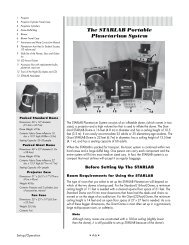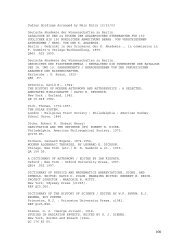K-6 Activities - Dudley Observatory
K-6 Activities - Dudley Observatory
K-6 Activities - Dudley Observatory
Create successful ePaper yourself
Turn your PDF publications into a flip-book with our unique Google optimized e-Paper software.
Note<br />
One set of the 13-volume PASS<br />
series (referred to throughout<br />
this section) is sent to you free<br />
when you return your Product<br />
Registration form. If you<br />
haven’t already received a set<br />
with your system, make sure to<br />
send in your form!<br />
Additional sets can be ordered<br />
through Science First/STARLAB,<br />
by calling 800-537-8703 or<br />
716-874-0133 or by visiting<br />
our Web site at: www.starlab.<br />
com.<br />
K–6 <strong>Activities</strong> • B–6 •<br />
Pre- and Post-STARLAB <strong>Activities</strong><br />
Overview<br />
Listed below are some activities that can be done by the classroom teacher either<br />
prior to or after being in STARLAB. Complete lessons follow in this K-6 section.<br />
Lessons for Grades K-3<br />
1. Do the “Horizon Lesson for Primary Grades” on page 10 to show young students<br />
how the horizon goes all the way to the ground.<br />
• Make your own constellations from bleach-spotted tissue paper.<br />
2. Do the “How to Make Constellations Pictures” lesson on page 21.<br />
• Punch the holes of one constellation through aluminum foil and a star map,<br />
then put foil on an overhead projector and have kids guess which constellation<br />
it is.<br />
• Punch holes through a star map in the bottom of a film can. Look at the<br />
constellation through light. (Film cans are free at film processing firms.)<br />
3. Use the seasonal Star Maps to learn constellations on pages 42-47.<br />
4. Do the “Circle Puzzle,” “Dots Puzzle,” and “Create a Constellation” lessons<br />
(from PASS Volume 5, Constellations Tonight*) to show students how ancient<br />
Greeks and Romans came up with the constellations.<br />
Lessons for Grades 4-6<br />
1. Do the “Meteoroids & Craters” experiments from PASS Volume 7, Moons of the<br />
Solar System.<br />
2. Do the Oobleck experiment (from Oobleck: What Do Scientists Do? in the GEMS<br />
series — see resource list on page 45 for purchasing information).<br />
3. Make a Star Clock using the template on page 12 of this section (from Earth,<br />
Moon and Stars — GEMS).<br />
4. Send seasonal Star Maps home with your students so that they can practice finding<br />
constellations and planets with their parents. See templates on pages 42-47.<br />
5. Do the “What Are Your Ideas About the Earth?” worksheet to find out about students’<br />
misconceptions about our earth (from Earth, Moon and Stars — GEMS).<br />
6. Make polystyrene “moon balls” to show the moon’s phases. (See PASS Volume<br />
7, Moons of the Solar System).<br />
7. Encourage students to track the moon’s phases and locations for a month.<br />
8. Make a Moon Phaser (see page 13).





